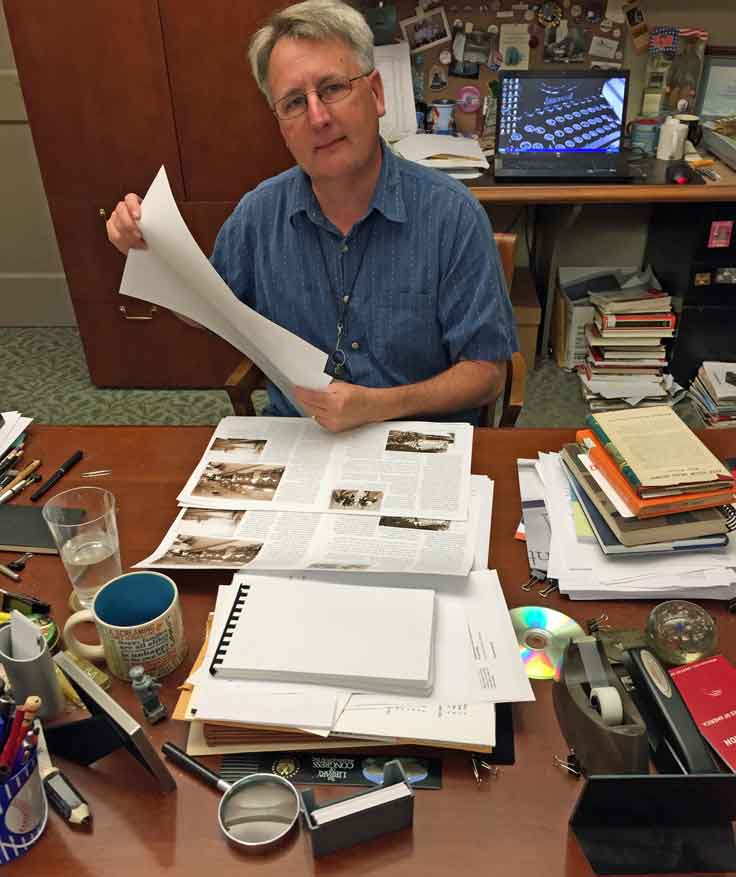
Plan your visit
Traces and Me
March 19, 2018

In the spring of 1938 a reporter for the Indianapolis Times newspaper, John Bartlow Martin, seeking to break away from the daily grind of journalism, used his experiences visiting the Dominican Republic to produce a freelance article on the brutal dictatorship of Rafael Trujillo for Ken, a national magazine edited by Arnold Gingrich. After a few rewrites, Gingrich accepted the article and paid Martin $150. For years until it finally wore out, Martin carried in his wallet the voucher from that check – the first he had received as a freelance writer.
I, too, can share Martin’s excitement and pride at being published in a magazine, as it is an emotion I had when, in 1990, my submission, a department titled “Destination Indiana,” was accepted by editor J. Kent Calder for publication in the Indiana Historical Society’s popular history magazine Traces of Indiana and Midwestern History. The magazine had been in existence for a little more than a year. Distributed as a benefit of membership to IHS members, Traces was conceived as a way to bring to the public good narrative and analytical history about Indiana in its broader contexts of region and nation.
At that time, I worked as IHS’s public relations coordinator and had been involved in publicizing the magazine to its new readers, including helping coordinate a contest to name the periodical. As a former reporter for two Indiana daily newspapers – the Renssealaer Republican and Anderson Herald, and as someone who possessed a lifelong interest in and passion for history, I wanted to merge these interests and have my writing appear in Traces. But, how to achieve this goal? Although I had published some feature articles on history-related topics for Outdoor Indiana, the colorful magazine of the Indiana Department of Natural Resources, I had never written anything for a history-based journal and had little familiarity with the scholarly research needed to produce an article for Traces.
Luckily for me, the magazine’s staff – managing editor Kent Calder and his assistant editor Megan McKee – were looking for ideas for new departments in the magazine that would appear on a regular basis and highlight aspects of Indiana history not normally covered by articles. I was only too eager to aid in their efforts by creating a department that I could write: but what kind? Before coming to IHS, I had worked in the public relations department for the Indiana State Museum system, which included a number of historic sites dotting the Hoosier landscape. In my duties at the museum, I was responsible for writing brochure copy for these sites and learned much about the state’s past. My work in producing these brochures really opened my eyes to the rich variety of Indiana’s history, including such figures as Ernie Pyle, Gene Stratton-Porter, Levi Coffin, J.F.D Lanier and T.C. Steele. In addition to my work with the state museum, I had visited other historic sites outside the state museum system during IHS conferences and on weekend excursions. Given all this experience, why not, I reasoned, suggest having a regular department in Traces to highlight such historic places, and in doing so help educate Hoosiers about what was available to them, in most cases just a few miles from their doors?
I shared my idea with Kent and Megan, who, thankfully, both shared my enthusiasm for the department. The department’s success owes much to both of these fine editors, not the least of which was their help with naming the department. Before deciding on “Destination Indiana,” we considered and rejected such titles as: “Off the Beaten Path,” “Indiana Highways,” “Indiana Almanac,” “You Can’t Get There From Here,” “Wandering Indiana” (a takeoff on a Indiana Department of Tourism slogan that had received its share of ridicule), “This is Indiana,” “Hoosier Byways” and “Exit: Indiana.”
Both editors, and later editorial assistant George Hanlin, also ably assisted me in the sometimes painful process of learning how to write for a history magazine. Later, with my column firmly established, I dared to write my first full-scale article for Traces, “Celebrating Statehood: Indiana’s 1916 Centennial,” published in the magazine’s summer 1991 issue. Today, I can look with satisfaction at a shelf filled with 27 other articles that have appeared in the magazine.
With Calder’s departure in 1999, I was lucky enough to be selected as the new editor of Traces – a post I have been proud to hold as the magazine has reached its 30th year of publication. Over the years Traces has been a place where readers can come to find the best writers in the state. The magazine will also continue its tradition of nurturing long-term relationships with its writers, including such dedicated contributors as Nelson Price, Rachel Berenson Perry, Julie Young, Douglas Wissing, Randy Mills, David Smith and James H. Madison. In working with these and other contributors I will try to keep in mind the advice given by the writer John Jerome, who once noted that from an author’s point of view, an editor’s first job is to assist in the execution of the writer’s intent. “If the writer’s intent is wrong,” said Jerome, “then a good editor tries to refocus that intent, to cajole or tease or somehow seduce the writer into a better one.” I look forward to cajoling and teasing Traces writers for many issues to come.









